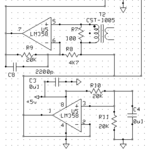VirusX2
Member level 4
Hi all, i have a LEM voltage transducer (LV 25-P). As the datasheet says the maximum measuring resistor is 190 or 350 ohm according to the measuring range and supply. I want to drive the output with a current to voltage op-amp so i convert the LEM's output into voltage and offset it by 2.5V. If i use the measuring resistor topology i need an 82 ohm resistor. So if i use a current to voltage op-amp can the circuit on the image work?




